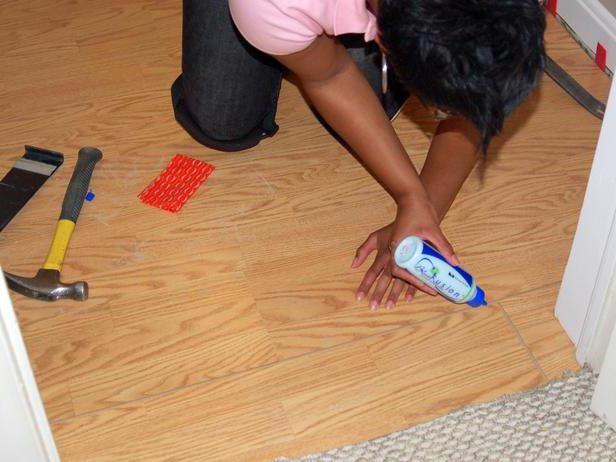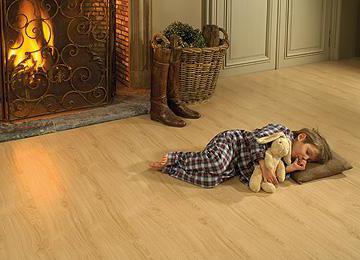How to choose a laminate for a water-heated floor? Expert reviews
Warm floors can serve their owners for a long time and reliably, if they are properly installed and a suitable coating is selected. The floor can be created from any materials: concrete, wood, linoleum and so on. One of the optimal materials is considered to be a laminate for a water-heated floor, which has certain parameters and properties.
Laminate has long been popular for flooring installation. It is convenient to operate, it has a stylish appearance and a wide variety of colors and textures.
Laminate for a warm water floor: advantages and properties
Among the advantages of such a floor covering for underfloor heating, the following points should be highlighted:
- the thermal conductivity of the laminate is low, it allows for heat transfer at the level of 40-50 degrees;
- laminate flooring can reduce the consumption of thermal energy by 40 percent when compared with other home heating systems;
- when using this type of heating of a laminate floor, there is no magnetic field that negatively affects human health;
- laminate for users emphasizes this) keeps the heating surface dry, which protects the floor from fungus, mold and dampness in the room;
- The tandem of laminate and underfloor heating is a clean and ecological solution for home heating.
In addition to the above advantages, such a floor in the room heats up almost instantly and evenly. The thermal system under the laminate increases the service life of the coating several times.
The existing disadvantages of the described tandem are the incorrect application of the installation technique, both the heating system itself and the laminate.
Underfloor heating features
Most experts do not recommend the heating system itself in residential premises for a water-heated floor, since it requires special pumps and containers for pumping system fluid, which occupy a significant amount of space. Also, in the event of a pipe break in the floor, water will spoil not only the laminate itself, but also relations with neighbors from below. Therefore, such a tandem, beneficial in any conditions, is installed in private houses, cottages and dachas.
Laminate for a warm water floor: which one to choose?
Not every type of laminate is suitable for use with underfloor heating. Traditional laminate flooring, which can be found in every hardware store, cannot be used for underfloor heating, as it has a very low thermal conductivity. What is needed is a material that is both dense and thin, able to pass the heat coming from below and be resistant to external pressure.
Which laminate for a warm water floor should be chosen in the construction market or in a store? Experts advise you to take a floor covering with a special marking in the form of a special pictogram on the product packaging or in the accompanying documents, indicating the suitability of the material for use in conjunction with underfloor heating. At the same time, the laminate for underfloor heating is not intended for electric underfloor heating and vice versa.
So that customers can distinguish the required laminate, the packaging depicts a symbol of water, writes the formula H 2 O or puts the inscription "water". If there is no specialized marking, then such a floor covering is considered an ordinary standard, intended for floor installation without additional heating systems.

Laminate without marking
Which laminate is suitable for a warm water floor if it does not have a special designation? Many manufacturers of high-quality and inexpensive floor coverings (both domestic and foreign) do not put special marks on what moments this or that material is intended for. Therefore, according to building standards, a laminate with a thermal resistance of no more than 150 watts is excellent for underfloor heating. In this case, the substrate should be made of a synthetic porous material that minimally delays the thermal wave.
Many users who have installed a laminate for a water-heated floor at home are advised to pay attention to the thickness of the board when choosing a coating - from 8 to 10 mm. Such material will be durable and reliable, and will also pass heated air well.
In addition, the purchased floor material must be characterized by high water resistance and a maximum load of 500 kg / m2. With the right selection of material, its service life will be at least 50 years.

In addition to the above recommendations, you should choose a laminate that is more durable and resistant to abrasion. It is better to mount a floor covering of at least 32 class on a warm floor. There are no traces of furniture on such a material, it serves its owners longer and does not lose heat conductivity.
How does such a system work?
They are laid in a cement screed, which ensures their greater safety. A special insulating material is laid under the pipes, which prevents heat loss through the ground or reinforced concrete floors. The heating system is covered from above with a synthetic substrate that protects the coating material, and the laminate itself for a water-heated floor is mounted directly.
During the operation of the heating system, the laminate heats up to 50 degrees, the heat from the floor rises up and thereby heats the entire room. The heat transfer of such a tandem is very high. Even after the heat supply to the system is turned off, the pipes and the laminate itself keep the temperature for a sufficiently long time.

Conclusion
The "warm floor" system itself is very popular due to its cost-effectiveness and efficiency. In the house where it is installed, it is always cozy and warm, there are no panels and radiators on the walls, all rooms are evenly heated, everywhere is dry and comfortable. However, not every floor covering can provide the desired effect. If the floor is mounted from a material that is not suitable for this system, then either it will not be able to pass enough heat into the room, or it will get very hot, which will bring some discomfort to those living in the house.
Therefore, a warm floor can work as efficiently as possible only in conjunction with a special coating, and the laminate takes the first place here. But such material should be designed to work in tandem with a warm floor according to the parameters described above.
Therefore, when choosing a laminate for underfloor heating, you should pay attention to its marking and technical characteristics. Then the money invested in the installation of the heating system and the floor will bring beauty, warmth, coziness and comfort to all family members.


 Masonry mortars for brick kilns
Masonry mortars for brick kilns Why do the windows fog up in the apartment
Why do the windows fog up in the apartment Construction and schemes of brick ovens
Construction and schemes of brick ovens How to lay paving slabs: tips and tricks
How to lay paving slabs: tips and tricks How to drill bathroom tiles
How to drill bathroom tiles Monolithic slab on coarse soil
Monolithic slab on coarse soil Which electric heater is economical
Which electric heater is economical